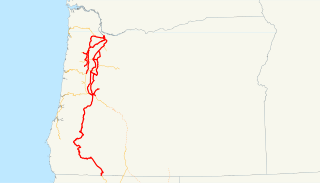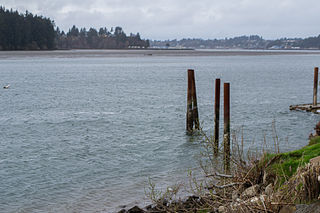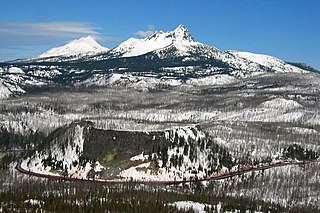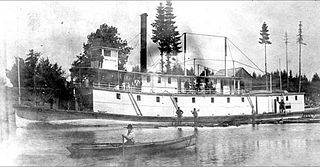| Reporting mark | OPR |
|---|---|
| Locale | Oregon |
| Dates of operation | 1880–1894 |
| Predecessor | Willamette Valley and Coast Railroad |
| Successor | Oregon Central and Eastern Railroad |
| Track gauge | 4 ft 8 1⁄2 in (1,435 mm) |
| Headquarters | Corvallis, Oregon |
Oregon Pacific Railroad Linear Historic District | |
 | |
| Nearest city | Santiam Junction, Oregon |
|---|---|
| Coordinates | 44°27′10″N121°53′57″W / 44.45278°N 121.89917°W Coordinates: 44°27′10″N121°53′57″W / 44.45278°N 121.89917°W |
| Area | 172.3 acres (69.7 ha) |
| Built | 1887 |
| Built by | Colonel Eccelson |
| NRHP reference # | 99001285 [1] |
| Added to NRHP | October 29, 1999 |
Oregon Pacific Railroad was a railroad in western Oregon, United States, from 1880 to 1894, when it was sold to the Oregon Central and Eastern Railroad. A substantial part of the Oregon Pacific's abandoned right-of-way is preserved as Oregon Pacific Railroad Linear Historic District.

Oregon is a state in the Pacific Northwest region on the West Coast of the United States. The Columbia River delineates much of Oregon's northern boundary with Washington, while the Snake River delineates much of its eastern boundary with Idaho. The parallel 42° north delineates the southern boundary with California and Nevada. Oregon is one of only three states of the contiguous United States to have a coastline on the Pacific Ocean.
It was created and owned by Thomas Egenton Hogg. [2] [3]
Thomas Egenton Hogg (1828–1898) was a master in the Confederate States Navy who participated in raids on Union ships during the American Civil War. He was captured and sentenced to death, but was eventually released from prison, after which he became a businessman and railroad promoter in the U.S. state of Oregon. He worked to build the Oregon Pacific Railroad, though his dream to create a transcontinental railroad with its western terminus on the Oregon Coast was never realized.
Hogg organized the Corvallis and Yaquina Bay Railroad in 1872, with the vision to build a new transcontinental line eastward from the Oregon coast and provide Corvallis with a railroad connection. At the time, the next nearest rails were the Oregon Central Railroad in St. Joseph, and the Oregon and California Railroad in Albany. Hogg reorganized the railroad as the Willamette Valley & Coast Railroad, and ground was first broken in Corvallis on May 17, 1877. The Oregon Pacific Railroad was organized on September 15, 1880, as a successor to the WV&C. [2]

The Oregon Central Rail Road was the name of two railroad companies in the U.S. state of Oregon, each of which claimed federal land grants that had been assigned to the state in 1866 to assist in building a line from Portland south into California. The "East Side Company" of Salem, supported by businessman Ben Holladay, eventually received the grant for its line east of the Willamette River, and was reorganized in 1870 as the Oregon and California Railroad (O&C), which completed the line in 1887. Portland supported the competing "West Side Company", which only built to McMinnville, and was sold to the O&C in 1880. The O&C was later acquired by the Southern Pacific Company, and mostly remains as part of the Union Pacific Railroad's I-5 Corridor; the West Side line is now operated by the Portland and Western Railroad between Beaverton and Forest Grove.
Saint Joseph is an unincorporated community in Yamhill County, Oregon, United States. It is located about two miles west of Lafayette near Oregon Route 99W. The area is sometimes known as "St. Joe".

The Oregon and California Railroad was formed from the Oregon Central Railroad when it was the first to operate a 20-mile (32 km) stretch south of Portland in 1869. This qualified the railroad for land grants in California, whereupon the name of the railroad soon changed to Oregon & California Rail Road Company. In 1887, the line was completed over Siskiyou Summit, and the Southern Pacific Railroad assumed control of the railroad, although it was not officially sold to Southern Pacific until January 3, 1927.
Hogg originally intended to terminate the line at Seal Rock on the Oregon Coast. [2] In anticipation of the railroad's arrival, the town was platted in 1877 with pedestrian-friendly public spaces and resort hotels that would accommodate train travelers, but the line was instead routed through Toledo to end at Yaquina, resulting in financial ruin for many who invested in Seal Rock. [2] [4]

Seal Rock is an unincorporated coastal community in Lincoln County, Oregon, United States, between Newport and Waldport on U.S. Route 101.

Toledo is a city located on the Yaquina River and along U.S. Route 20 in Lincoln County, in the U.S. state of Oregon. The population was 3,465 at the 2010 census. The city was a 2009 All-America City Award finalist.

Yaquina, at one time a thriving port called Yaquina City, is an unincorporated community in Lincoln County, in the U.S. state of Oregon. It is near the mouth of the Yaquina River, on the east side of Yaquina Bay, and is a 3-to-4-mile drive from Newport. The Oregon Press Association, which became the Oregon Newspaper Publishers Association, was founded in Yaquina City in 1887.
To the east, the line extended as far as Idanha, 15 miles (24 km) short of Santiam Pass before running out of money. [2] [3] Hogg purchased the steamship Yaquina City to provide a direct link to his railroad between Yaquina and San Francisco. Yaquina City successfully completed several voyages, until she ran aground at Yaquina Bay in 1887 due to a rudder failure. Despite the Yaquina City being insured, Hogg had just lost his biggest source of income and could not immediately replace the steamer. Hogg's contract with the government stated however, that if he could establish railroad service over the Cascade Mountains, he could receive a massive land grant. By selling this land, enough money could be made to keep the railroad in business. [5] To get the grant, some additional track was laid over Santiam Pass. Hogg had mules pull some cars a few times to assert right of way. [2] Hogg Rock near Santiam Pass is named for T. Egenton Hogg for his railroad which went around the rock. Track was also laid in the canyon of the Malheur River to reserve that pass for the railroad.

Idanha is a city on the Marion County/Linn County line in Oregon, United States, on Oregon Route 22 and the Santiam River. The population was 134 at the 2010 census.

Santiam Pass is a 4,817-foot (1,468 m) mountain pass in the Cascade Range in central Oregon in the United States. It is located on the border between Linn and Jefferson counties, about 18 mi (29 km) northwest of Sisters, between the prominent volcanic horns of Three Fingered Jack to the north and Mount Washington to the south. Several other smaller volcanoes, including cinder cones and tuyas, are found near the summit of the pass. U.S. Route 20 connects eastern Oregon with the valley of the Santiam River on the west via Santiam Pass. One of the 19 or 20 lakes by the name of Lost Lake is located beside the highway just west of Santiam Pass. The pass may be approached from the west by three distinct routes:

Yaquina Bay is a coastal estuarine community found in Newport, Oregon, United States. Yaquina Bay is a semi-enclosed body of water, approximately 8 km² (3.2 mi²) in area, with free connection to the Pacific Ocean, but also diluted with freshwater from the Yaquina River land drainage. The Bay is traversed by the Yaquina Bay Bridge. There are three small communities that border the Yaquina River and Bay; Newport, Toledo and Elk City. The Yaquina Bay in Newport is a popular tourist destination along the Pacific Coast Highway. It is also an important estuary for the ecology and economy of the area.

In 1888, Hogg purchased the Ocean liner Caracas from the Red D Line to replace the Yaquina City. [6] [7] She was renamed Yaquina Bay and towed to Yaquina. Before steamship service could restart however, Yaquina Bay broke free the tugboat which was hauling her on December 9, 1888, and ran aground near the wreck of the Yaquina City. Like the Yaquina City, the Yaquina Bay was declared a total loss. Unfortunately, the Yaquina Bay was not insured which left Hogg no choice but to admit defeat and leave the state of Oregon a broke man (This statement is not entirely true. The wreck of the steamships did not bankrupt Colonel Hogg or the railroad, and he did not "leave the state a broken man". The railroad continued to function under Colonel Hogg's "leadership" (such as it was) until, after his failure to meet the annual bond interest payments, a rival faction of bondholders forced the railroad into receivership. Colonel Hogg served as receiver until 1893 when he was removed for malfeasance. The failure of the Oregon Pacific Railroad had more to do with the collapse of the securities market following the Silver Panic of 1891 and the Depression of 1893 than it did the wreck of the steamships, though the way Hogg and his associates managed the financial affairs of the railroad left the company without the resources to weather any financial reverses. Locals believed that Portland based companies had sabotaged both of Hogg's vessels to ensure no business was taken away from them. [5] Coincidentally, the Yaquina Bay's sister ship, Valencia , would end in a similar fate; running aground off Vancouver Island with the loss of 116 people. [8]

An ocean liner is a passenger ship primarily used as a form of transportation across seas or oceans. Liners may also carry cargo or mail, and may sometimes be used for other purposes.

The SS Caracas (1881–1889) was a coastal passenger steamship built by William Cramp & Sons in Philadelphia. She was the older sister ship to the Valencia. Both Caracas and Valencia served from New York City to Venezuela. The short life of Caracas ended in 1889, when she ran aground in Yaquina Bay under the name Yaquina Bay.

SS Valencia was an iron-hulled passenger steamer built as a minor ocean liner for the Red D Line for service between Venezuela and New York City. She was built in 1882 by William Cramp and Sons, one year after the construction of her sister ship Caracas. She was a 1,598 ton vessel, 252 feet (77 m) in length. In 1897, Valencia was deliberately attacked by the Spanish cruiser Reina Mercedes off Guantanamo Bay, Cuba. The next year, she became a coastal passenger liner on the U.S. West Coast and served periodically in the Spanish–American War as a troopship to the Philippines. Valencia was wrecked off Cape Beale, which is near Clo-oose, on the west coast of Vancouver Island, British Columbia, on 22 January 1906. Since her sinking killed 100 people, some classify the wreck of Valencia as the worst maritime disaster in the "Graveyard of the Pacific", a famously treacherous area off the southwest coast of Vancouver Island.
The railroad entered bankruptcy in October 1890. In 1894 it was sold to A.B. Hammond and renamed the Oregon Central and Eastern Railway, and again in 1897 was reorganized as the Corvallis and Eastern Railroad. In 1907 the C&E was sold to the Southern Pacific. [2] [3] [9]
Some of the tracks were submerged by Detroit Lake in the 1950s when the Detroit Dam was completed. In 1999, the line's corridor from Idanha to the Cascade summit was designated as a historic district and listed on the National Register of Historic Places. [1]










